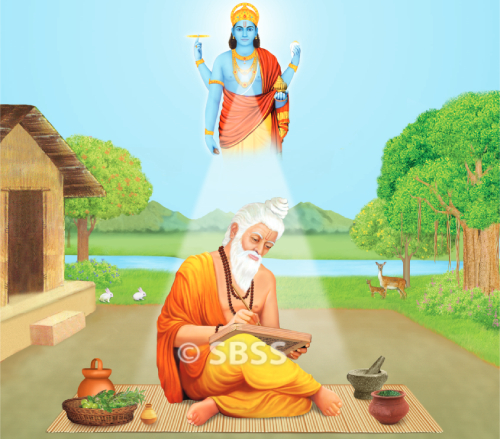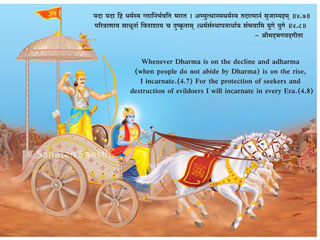Ayurveda for a healthy life ! – 31/2024 on 1. 7.2024

Aama
During digestion, the food is broken down into smaller and smaller particles till they are broken down ultimately into fine particles, which can be easily absorbed and assimilated. Incompletely digested food products, which cannot be absorbed, remain in the gastro-intestinal tract and are passed in the stools or vomited. The partially digested food which can be absorbed, but cannot be assimilated by tissues is termed as Aama.
When the amount of food taken is beyond one’s digestive capacity, it leads to formation of Aama. Thus, a person with good digestive power will hardly ever form Aama. On the other hand, a person with weak digestive power quickly forms Aama, even if he takes limited or moderate amount of food stuff. Aama is also formed when doshas affect each other. In dwandvaja & tridoshaja diseases, more than one doshas are increased in the body & affect the tissue. In these conditions, doshas do not affect each other.
यत्तत्सात्म्याअन्ये दोषेभ्य एवाति दुष्टेभ्योऽन्यमूर्च्छनात् । – वा. सू १३.२६
When the increased doshas attack each other that is combine chemically with each other, the result is the formation of Aama (a toxic chemical compound). Aama formed in this manner is highly toxic to the tissues and is encountered in states of toxemia and other fulminating diseases affecting the entire body.
Table showing formation of Aama from incomplete digestion of food.
| Sr. No. | Diet | Digestive- power | Tissue- enzymes | Remarks |
| 1. | + | + | + | Formation of tissues, normal doshas and waste products in appropriate amounts |
| 2. | Slightly more+ | + | + | Fat, doshas and waste products in increased amount |
| 3. | ++ | + | + | Aama formation in gastro-intestinal tract. |
| 4. | + | + | – | Aama formation in tissues |
| 5. | + | _ | + | Aama formation in gastro-intestinal tract |
| 6. | ++ | ++ | + | Aama formation in tissues |
| 7. | +++ | + | + | Aama + undigested food in gastro-intestinal tract |
Aama is one of the important causes of majority of diseases. The first variety of Aama resulting from incomplete digestion of food accumulates slowly in genetically weak organs or organs weakened by obstruction to its blood vessels or its ducts and gives rise to subacute or chronic diseases. Aama can affect doshas, tissues or waste products. When Aama afflicts various doshas, they are termed saama doshas. Thus, one gets saama Vata, saama Pitta and saama Kapha.
आमेन तेन सम्पृक्ता दोषा दूष्याश्च दूषिताः ।
सामा इत्युपदिश्यन्ते ये च रोगास्तदुद्भवाः ।। – वा. सू. १३.२७
The stage of disease where Aama doshas dominate is termed as saama stage of disease. When these Aama doshas are digested either by tissue enzymes or by enzymes in the digestive tract, one gets rid of Aama doshas & this is termed as niraama stage of the disease.
1. Characters of Aama
It is heavy, unctuous, viscid, foul smelling and toxic fluid. It contains fine thread like material. It can have many colours and is the root cause of all illnesses.
General symptoms due to Aama doshas are as follows –
Obstruction to passages, improper functioning of heart, weakness, heaviness, obstruction to the free movement and functioning of Vata; laziness, drowsiness, indigestion, heaviness in the stomach, expectoration, retention of urine and stools, anorexia and exhaustion. The pulse is heavy, slow and strong. Urine is slimy, foul smelling, of varying colours and has high specific gravity. Stools may have shades of various colours. It is foul smelling and sinks in water. Tongue is slimy and heavily coated, the coating being difficult to remove by cleaning the tongue.
One may get Aama stage in relation to dosha that is Vata, Pitta, Kapha and dhatus that is body fluids, blood etc. and malas that is waste products.
2. Symptoms of Saama Vata and Niraama Vata
Pain of various types, gaseous distension, weak digestive power, constipation, oedema, drowsiness or disturbed functions of Vata are the symptoms of saama Vata. The symptoms of saama Vata are increased by administration of oils & ghee.
निरामो विशदो रूक्षो निर्विबन्धोऽल्पवेदनः ।
विपरीतगुणैः शान्तिं स्निग्धैर्याति विशेषतः ।। – मा. नि. (मधुकोश)
Sense of clarity and dryness, free passage of wind and stools, diminution in the severity of pain and its relief by medicated oil and ghee are the manifestations of niraama vata.
3. Symptoms of Saama and Niraama Pitta
दुर्गन्धं हरितं श्यावं पित्तमम्लं स्थिरं गुरु ।
आम्लिकाकण्ठहृद्दाहकरं सामं विनिर्दिशेत ।। – मा. नि. (मधुकोश)
Saama Pitta is foul smelling, greenish-black, sour, heavy and steady. It is usually secreted in profuse amount and gives rise to burning in throat and cardiac region.
Niraama Pitta is reddish-yellow, hot, pungent, mobile and does not have any smell. It imparts digestive power, taste and strength.
4. Symptoms of Saama and Niraama Kapha
Saama Kapha is heavy, viscid, thick, foul smelling, turbid, dirty and thready. It destroys appetite and impairs easy belching.
फेनवान्पिण्डितः पाण्डुर्निःसारोऽगन्ध एव च ।
पक्वः स एव विज्ञेयश्छेदवान्वक्त्रशुद्धिकृत् ।। – मा. नि. (मधुकोश)
Niraama Kapha becomes clear, foamy, white, sweet and does not have foul smell. It imparts a clean sensation to the mouth and throat.
5. Treatment of Aama doshas
Fasting is the best method of treatment of Aama stage of any disease. One should undertake the fast till Aama is digested that is the symptoms of “Aama” or “indigestion” disappear and one feels light. The administration of medicine is contraindicated in this stage, as the medicine itself may not be digested and may exert local irritant action or exhibit abnormal toxic symptoms. At the most, one may administer medicines, which will act as digestives or stimulate secretion of digestive juice. In case the patient has nausea and retching, one should administer an emetic. Purgatives are usually contraindicated as the toxins of Aama driven into the intestine then can be easily absorbed leading to toxaemia.
प्रवृत्तान् प्रागतो दोषानुपेक्षेत हिताशिनः । – वा. सू. १३.३२
If Aama dosha is naturally getting out of the body example in Aama stage of vomiting and diarrhoea, one should not interfere with it by administering anti-emetic or astringent medicines. This may lead to retention of toxins and a state of toxaemia.
पाचनैर्दीपनैः स्नेहैस्तान्स्वेदैश्च परिष्कृतान् ।
शोधयेच्छोधनैः काले यथासन्नं यथाबलम् ।।
हन्त्याशु युक्तं वक्त्रेण द्रव्यमामाशयान्मलान् ।
घ्राणेन चोर्ध्वजत्रूत्थान् पक्वाधानाद्गुदेन च ।। – वा. सू. १३.२९-३१
Fasting is also indicated, when Aama doshas have accumulated in the tissues or has spread all over the body as in states of toxaemia. One should get rid of Aama by stimulating the tissue enzymes, which would digest Aama locally. Later, one should bring the digested doshas to the gastro-intestinal tract by administration of medicated oils and ghee and induction of sweating. Finally, these doshas in the gastro-intestinal tract should be removed from the body by administration of emetics, purgatives or enema.

 Detergent found in ice-creams, phosphoric acid in soft drinks !
Detergent found in ice-creams, phosphoric acid in soft drinks ! Radiant Thoughts of Sachchidananda Parabrahman (Dr) Jayant Athavale
Radiant Thoughts of Sachchidananda Parabrahman (Dr) Jayant Athavale Law banning Conversion of Religion is against Individual Freedom : Babbles Former Judge S Muralidhar
Law banning Conversion of Religion is against Individual Freedom : Babbles Former Judge S Muralidhar Editorial : Khalistan, Balochistan and Pakistan
Editorial : Khalistan, Balochistan and Pakistan After India becomes a ‘Hindu Rashtra’, Russia will embrace Hinduism and spread it globally : Nostradamus’ Prophecy
After India becomes a ‘Hindu Rashtra’, Russia will embrace Hinduism and spread it globally : Nostradamus’ Prophecy ‘Halt Public Spending on Aurangzeb’s Tomb, Prioritise Maharashtra’s Heritage’ : HJS
‘Halt Public Spending on Aurangzeb’s Tomb, Prioritise Maharashtra’s Heritage’ : HJS